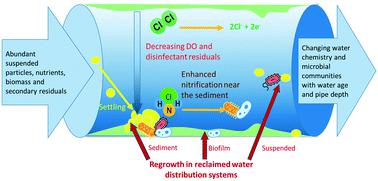当前位置:
X-MOL 学术
›
Environ. Sci.: Water Res. Technol.
›
论文详情
Our official English website, www.x-mol.net, welcomes your
feedback! (Note: you will need to create a separate account there.)
Sediment and biofilm affect disinfectant decay rates during long-term operation of simulated reclaimed water distribution systems
Environmental Science: Water Research & Technology ( IF 3.5 ) Pub Date : 2020-04-03 , DOI: 10.1039/c9ew00978g Ni Zhu 1, 2, 3, 4 , Kris Mapili 4, 5, 6 , Haniyyah Majeed 1, 2, 3, 4 , Amy Pruden 1, 2, 3, 4 , Marc A. Edwards 1, 2, 3, 4
Environmental Science: Water Research & Technology ( IF 3.5 ) Pub Date : 2020-04-03 , DOI: 10.1039/c9ew00978g Ni Zhu 1, 2, 3, 4 , Kris Mapili 4, 5, 6 , Haniyyah Majeed 1, 2, 3, 4 , Amy Pruden 1, 2, 3, 4 , Marc A. Edwards 1, 2, 3, 4
Affiliation

|
Changing chemistry and microbiology of reclaimed water as it is conveyed via reclaimed water distribution systems (RWDSs) can influence water quality at the point of use. Two simulated RWDSs comprised of 0.32 cm tubes (“Tube” RWDSs) and 10 cm diameter pipes (“Pipe” RWDSs) were designed to investigate how extremes in water age (32 min versus 5 d) and surface area to volume ratio (6.25 cm−1versus 0.20 cm−1) affect the potential for sediment accumulation, disinfectant decay, and chemical and microbial water quality under controlled treatment conditions. Effluent from a conventional municipal wastewater treatment plant was breakpoint chlorinated and treated with and without biological filtration, followed by three disinfectant conditions: no residual, 4 mg L−1 chlorine or 4 mg L−1 chloramine. After three years of operation, accumulated sediment occupied 0.32–3.2% of the total volume of the first pipe segment. The unfiltered chlorine condition had an order of magnitude less influent turbidity and sediment accumulation than conditions with no residual or chloramine, resulting in lower levels of biological activity and slower depletion of disinfectants and dissolved oxygen. The sediment in pipes receiving chloraminated water was highly biologically active and created a high disinfectant demand due to nitrification. In contrast, the tube RWDSs did not accumulate sediment. The Tube rigs with chloramine and no residual had heavy bio-foulant growth, which resulted in rapid depletion of chloramine. Biofilm was the main source of disinfectant demand in the chlorine tubes. An improved holistic understanding of RWDSs chemistry, biology and operation will help achieve desired water qualities at the point of use.
中文翻译:

在模拟再生水分配系统的长期运行过程中,沉积物和生物膜影响消毒剂的腐烂率
通过再生水分配系统(RWDSs)输送的再生水的化学和微生物学变化会影响使用时的水质。设计了两个模拟的RWDS,分别由0.32 cm的管(“ Tube” RWDS)和直径为10 cm的管(“ Pipe” RWDS)组成,以研究水年龄的极限(32分钟对5 d)和表面积与体积之比(6.25 cm)-1和0.20 cm -1)在受控处理条件下影响沉积物堆积,消毒剂腐烂以及化学和微生物水质的可能性。对常规市政污水处理厂的废水进行断点氯化处理,并进行或不经过生物过滤处理,然后进行三种消毒条件:无残留,4 mg L -1氯或4 mg L -1氯胺。经过三年的运行,累积的沉积物占第一段管段总体积的0.32-3.2%。与没有残留氯或氯胺的条件相比,未过滤的氯条件的进水浊度和沉淀物沉积少一个数量级,从而导致较低的生物活性水平和更慢的消毒剂和溶解氧消耗速度。接收氯化水的管道中的沉积物具有很高的生物活性,由于硝化作用,产生了很高的消毒需求。相反,管RWDSs不会积聚沉积物。装有氯胺且无残留物的试管架具有严重的生物污垢增长,从而导致氯胺迅速耗尽。生物膜是氯管中消毒剂需求的主要来源。对RWDSs化学的全面了解,
更新日期:2020-04-03
中文翻译:

在模拟再生水分配系统的长期运行过程中,沉积物和生物膜影响消毒剂的腐烂率
通过再生水分配系统(RWDSs)输送的再生水的化学和微生物学变化会影响使用时的水质。设计了两个模拟的RWDS,分别由0.32 cm的管(“ Tube” RWDS)和直径为10 cm的管(“ Pipe” RWDS)组成,以研究水年龄的极限(32分钟对5 d)和表面积与体积之比(6.25 cm)-1和0.20 cm -1)在受控处理条件下影响沉积物堆积,消毒剂腐烂以及化学和微生物水质的可能性。对常规市政污水处理厂的废水进行断点氯化处理,并进行或不经过生物过滤处理,然后进行三种消毒条件:无残留,4 mg L -1氯或4 mg L -1氯胺。经过三年的运行,累积的沉积物占第一段管段总体积的0.32-3.2%。与没有残留氯或氯胺的条件相比,未过滤的氯条件的进水浊度和沉淀物沉积少一个数量级,从而导致较低的生物活性水平和更慢的消毒剂和溶解氧消耗速度。接收氯化水的管道中的沉积物具有很高的生物活性,由于硝化作用,产生了很高的消毒需求。相反,管RWDSs不会积聚沉积物。装有氯胺且无残留物的试管架具有严重的生物污垢增长,从而导致氯胺迅速耗尽。生物膜是氯管中消毒剂需求的主要来源。对RWDSs化学的全面了解,











































 京公网安备 11010802027423号
京公网安备 11010802027423号